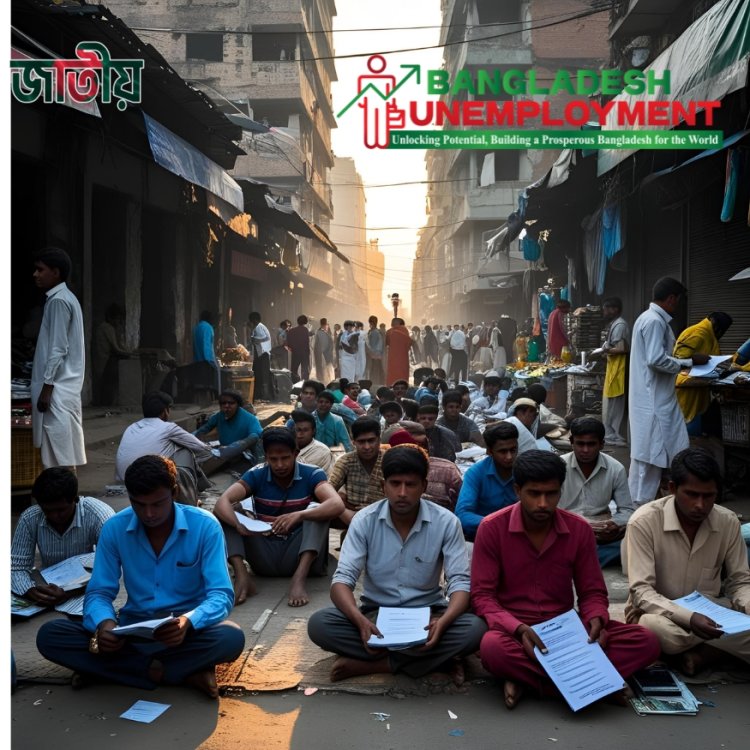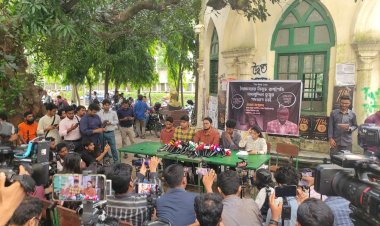Unemployment in Bangladesh: Structural Realities, Root Causes and the Road Ahead-Dr Raju Ahmed Dipu
Unemployment in Bangladesh: Structural Realities, Root Causes and the Road Ahead-Dr Raju Ahmed Dipu

Unemployment in Bangladesh: Structural Realities, Root Causes and the Road
Ahead.
Authored by Dr Raju Ahmed Dipu | BangladeshUnemployment.com

A Nation’s Growth Shadowed by Jobless Growth
Despite remarkable GDP growth and export expansion over the past two decades, unemployment remains one of Bangladesh’s most persistent challenges. While the official unemployment rate is estimated at 4.2%, this figure masks widespread underemployment, skill mismatches, and youth disillusionment. With over 2.5 million new jobseekers entering the market annually, the country faces a structural employment crisis that could hinder its ambition to become an upper-middle-income economy by 2031.
Labour Market Overview (2024–2025)
| Indicator | Status |
|---|---|
| Labour Force | ~72 million |
| Openly Unemployed | ~3.1 million |
| Underemployed | >20 million |
| Informal Employment | ~85% of workforce |
| Annual Job Demand | 2.5–3 million |
???? Source: Bangladesh Bureau of Statistics (BBS), ILO 2024
Root Causes of Unemployment: A Multi-Dimensional Breakdown
1. Education and Skill Deficit
-
A large proportion of university graduates are ill-equipped for the real job market, with over 60% lacking practical skills.
-
The education system emphasises theoretical knowledge over technical, vocational, and digital training.
-
Limited investment in TVET (Technical and Vocational Education and Training) restricts industrial alignment.
“There’s a disconnect between degrees and demands.” – ILO Bangladesh 2023
2. Political & Institutional Barriers
-
Nepotism and political favouritism influence government recruitment.
-
Youth from marginalised communities lack access to state-backed employment networks.
-
Political instability and crony capitalism deter foreign investment and SME expansion.
3. Weak Employment Policies & State Interventions
-
Absence of a National Youth Employment Guarantee Policy.
-
Delayed implementation of employment-friendly infrastructure outside major urban zones.
-
Limited start-up financing, especially for rural entrepreneurs and women.
4. Industrial Concentration & Urban-Centric Growth
-
Over-concentration of employment in RMG (Ready-Made Garments) and Dhaka-centric service sectors.
-
Neglect of agriculture modernisation and regional manufacturing hubs.
-
Poor logistics in northern and coastal divisions restrict industrial expansion.
5. Technological Displacement without Digital Inclusion
-
The rise of automation, AI, and e-commerce is displacing low-skilled workers.
-
However, only 27% of jobseekers have digital literacy, creating a digital divide.
???? Source: ADB “Digital Skills for Inclusive Growth” Report 2023
6. Migration Mismanagement
-
While migration supports over 10 million Bangladeshis abroad, many lack formal training, leading to low-wage, vulnerable jobs.
-
Recruitment scams and exploitation remain rampant.
Strategic Recommendations: Pathways to Employment Resilience
1. National Skills Acceleration Programme
-
Establish 1 technical institute per upazila, offering industry-standard courses in coding, robotics, renewable energy, healthcare, and agri-tech.
-
Partner with private sector and NGOs for certification and placement.
2. Digital Employment Ecosystem
-
Create a “One Youth One Skill” initiative under Digital Bangladesh 2031 Vision.
-
Integrate platforms like BangladeshStartup.com, BrandsMega.com, and BangladeshUnemployment.com as B2B and skill marketplaces.
3. Employment Guarantee Scheme (EGS)
-
Government-backed minimum employment for youth under 30 within 6 months of graduation.
-
Mandatory internships and apprenticeships through public-private collaboration.
4. Rural Entrepreneurship & Green Jobs
-
Expand Green Economy employment: solar installation, EV repair, smart irrigation.
-
Establish district-level youth cooperatives linked to banks and digital wallets.
5. Legal and Policy Reform
-
Introduce anti-nepotism clauses in government recruitment.
-
Mandate transparency in public hiring and digitisation of civil service exams.
Future Outlook: Bangladesh’s Employment Vision 2030
| Indicator | Target |
|---|---|
| New Jobs Created Annually | 3 million |
| Youth Start-ups (2030) | 1 million |
| TVET Graduates Per Year | 500,000+ |
| Formal Sector Employment Share | 60% |
| Unemployment Rate Target | Below 3% |
Conclusion: Nation-Building Beyond GDP
“True development means not only GDP growth but also dignity through decent work. Bangladesh’s youth deserve opportunity, not uncertainty.”
— Dr Raju Ahmed Dipu
As Bangladesh advances towards LDC graduation and SDG 8 (Decent Work & Economic Growth), employment must remain the top national priority. A well-integrated, decentralised and digitally-enabled employment ecosystem is not just desirable—it is essential.
Copyright & Content Claim Statement for International Use
Effective Date: 04.20.2025
Website: https://countrypolicy.com/
Content Owner: Raju Ahmed Dipu
This website and its contents—hereinafter referred to as “the Content”—comprise original intellectual material relating to unemployment planning, national economic development, political analysis, leadership communications, and global governance frameworks.
Intellectual Property Value & Justification
The Content is hereby valued at Ten Billion US Dollars ($10,000,000,000 USD). This figure is grounded in:
Over 17 years of political experience in national and international contexts,
Field-tested planning and policy design derived from direct observation and engagement across more than 50 countries,
17 years of strategic thought leadership, including role as 2nd Spokesperson of the Uprising of 05 August in Bangladesh (2021-2024)—a pivotal democratic mobilisation,
Extensive contributions to political reform, economic policy, and development strategies during political exile in Germany,
Involvement in transnational policy platforms and global think tanks,
Creation of a scalable and innovative unemployment planning model intended for use at both national and international levels.
Legal Ownership
Raju Ahmed Dipu is the exclusive and lawful owner of all published and unpublished materials available via https://countrypolicy.com/. This includes all ideas, data, policy blueprints, terminologies, research summaries, and communications presented or implied on the platform.
Protected Content Includes (but is not limited to):
Unemployment planning frameworks and job creation policies
Economic and political development models
Leader communications, strategic doctrines, and public policy innovations
Country-specific or cross-border governance plans
Any similar or derivative idea rooted in the original Content
International Legal Protections
This Content is protected by international law under:
The Berne Convention,
The World Intellectual Property Organization (WIPO) Treaties,
The TRIPS Agreement under the World Trade Organization (WTO), and
The intellectual principles of the Global Idea Policy.
Use Prohibited Without Authorisation
No individual, government, agency, academic body, political organisation, or corporate entity may reproduce, adapt, cite, republish, or use this Content—wholly or in part—without prior written authorisation from Raju Ahmed Dipu.
This restriction applies internationally, including but not limited to:
The United Kingdom, United States of America, European Union Member States, Republic of India, Japan, Canada, People’s Republic of Bangladesh, and all other sovereign nations and intergovernmental institutions.
Legal Enforcement
Violation of these protections may result in:
Immediate legal action and cease-and-desist notifications,
Claims for monetary damages up to $10,000,000,000 USD,
Public and diplomatic disclosure of violations if state-level infringement is detected,
Civil, criminal, or international tribunal proceedings, depending on the jurisdiction and nature of infringement.
For licensing, permissions, or legal correspondence, please contact: dipu@countrypolicy.com


















